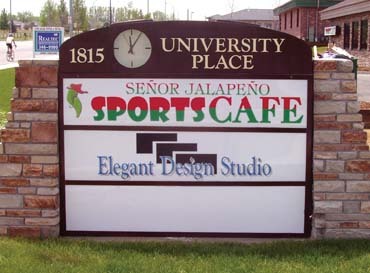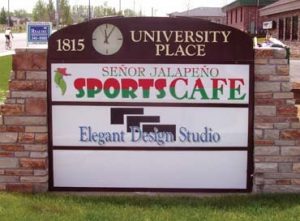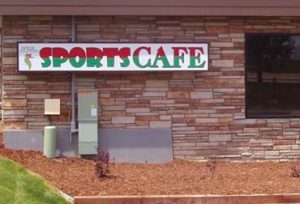Over the years, Smith Sign Studio's job costing has become more of an exercise in "customer costing" than a study of individual jobs. As a rule, our customers commission other projects from us, frequently within the annual costing period. We considered our work for J Arthur Financial, completed in 2004, both creative and profitable, so we eagerly accepted an even more challenging project from them in January 2005.
A new complex, University Plaza, would house Elegant Design, an interior-decorating studio, and a restaurant called Señor Jalapeño, as well as the space for another tenant. The main entry sign for the highly visible site, which sits on the corner by a bus stop and across from a K-12 local school, would also incorporate a clock.
We completed four jobs for J Arthur in the first three months of 2005: two, small, vinyl applications to windows and doors; the lighted monument sign with the clock; and follow-up neon work for the restaurant.
Both vinyl jobs were rush orders necessary to obtain appropriate licensing to open. In February, we applied the suite numbers before building inspection and approval. The vinyl and application tape totaled $10.58 (after adding the applicable use tax), which left a $64.42 contribution to overhead (COH) from the $75 price. The entire job, including onsite applications, required a half hour; $64.42 multiplied by two gives us a comparative COH per hour of $128.84.
Also, health-department regulations required the hours and logo be displayed on the door before it could open for business. For this vinyl job, we charged $157.50; the materials and expenses, including employee time, totaled $23.98, which left $133.52 to cover two hours and five minutes of work. This equals $64.19 COH per hour.
Too bad we can't fill our days with such quick, simple jobs, which are often the most profitable. Even though they boost income, they don't provide the excitement of designing something unique and durable.
When we calculate COH per hour, we include the time recorded by the owner and employees. Likewise, they're both counted when calculating the overhead spent on the job. But, to calculate net profit, we count only owner time, because employee time has already been paid.
Advertisement
The neon work for Señor Jalapeño also proved profitable. We invoiced this job at $1,415, which entailed new neon ($550), a transformer ($208.10) and assorted hardware ($8.58). Subtracting $766.68 ($550 + $208.10 + $8.58) from the sale left $648.32.
Kent spent eight hours and 50 minutes traveling back and forth to Longmont, where he "babysat" the gifted neon artist. While this knocked the COH per hour on this invoice down to $73.42, it still provided a respectable income.
The monument sign presented a greater challenge, which equals more "fun." For these enjoyable jobs, Kent trims the quote more closely. The $4,364.20 job was the quarter's highest sale.
An invoice, however, doesn't determine income. Materials purchased for the job, plus those taken from inventory, totaled $1,652.23, or 37.9% of the sign's total price. I try to keep costs below 30%. The $2,711.97 COH seems quite reasonable until you realize 43.42 hours are invested in this job. The resulting $62.44 COH per hour ($2,711.97/43.42) still provides a profit, but, with only $20.13 per hour net profit, it falls well short of our intentions.
We recovered the clock-monument costs on the fifth job, Señor Jalapeño's lighted wall sign (added in May). The inventory materials totaled $94.25. Kent incorporated a used sign can, and scrap Lexan® polycarbonate and angle iron for the brackets. Subtracting this cost, plus $85 for installation assistance, gives us a $995.53 COH. Fabrication and installation proceeded smoothly and, despite the extra time caused by reclaiming used materials, totaled only 12 hours and 20 minutes. This resulted in a $80.74 COH per hour.
We now have a total COH of $4,553.76 (sales – direct costs – inventory items) and an overall average COH per hour of $67.79 (COH/costed hours). But this is only the beginning.
Our 2004 overhead had been $46.24 per costable hour. Although we had planned to reduce that amount in 2005, it didn't seem feasible at the end of the first quarter. Our total overhead for three months, an enormous $19,146.93, was only $113.74 less than the same three months in 2004. In the first quarter, we totaled 464.44 costable hours on 90 jobs. This equaled a $41.33 hourly overhead (overhead/costable hours), compared to $38.42 per hour for 2004's first-quarter overhead. The only foreseeable solution would be to increase the hours we cost.
To evenly prorate the quarter overhead, we added 22 hours and 30 minutes to this total ( hour for each invoice written during the quarter). This helped cover bidding and paperwork hours. The resulting worktime costable to specific customers, 486.94 hours, was still approximately 15 hours less than 2004's 501.33 for the first quarter. Fewer hours typically increase the hourly costing rate.
Advertisement
Even with the added 22 hours, $19,148.93 divided by 486.94 equals an hourly OH rate of $39.33 per hour (which we'll use subsequently on all five jobs).
Continuing the prorating process, we multiplied this overhead rate by the costable hours (owner + employee hours) on each job, including the hour added for administration. After subtracting the overhead, we arrived at the net profit. Then, we divided net profit by owner hours to arrive at the final comparable figure, the net profit per hour on each individual job. Assigning hour to every job appropriates time to every job, even the rare one done so quickly no one records it. The net per hour on these five jobs ranges from $20.13 to $46.56. The net per hour for this customer is $27.73.
Kent and I must net enough to cover our personal expenses. Therefore, we're working industriously to increase my costable time, which is very low. Kent's 2004 hours were 56% costable, which is a very high percentage. Our combined hours, even with my increase, are approximately 25% costable. If we apply this ratio, we need four hours' income for every costable hour.
Conversely, if we want equivalent income, we must net at least 400% of our employees' hourly rate (including benefits). Thus, we should net approximately $50 per costable hour. The example we've provided falls short.
We enjoy self-employment's other benefits. We're available for our children, grandchildren and parents. We sit on civic boards and attend functions on workdays. We control our own lives. Still, it would be nice if we didn't work 78 hours a week to pay the bills ($50/$27.84 3 40).


 Tip Sheet2 weeks ago
Tip Sheet2 weeks ago
 Photo Gallery3 days ago
Photo Gallery3 days ago
 Ask Signs of the Times5 days ago
Ask Signs of the Times5 days ago
 Real Deal2 weeks ago
Real Deal2 weeks ago
 Paula Fargo23 hours ago
Paula Fargo23 hours ago
 Benchmarks1 week ago
Benchmarks1 week ago
 Photo Gallery23 hours ago
Photo Gallery23 hours ago
 Women in Signs2 weeks ago
Women in Signs2 weeks ago















